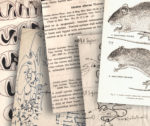Genetic diversity of the white-eared opossum Didelphis albiventris (Didelphimorphia: Didelphidae) in Argentina
M. Amelia Chemisquy, Facundo M. Morinigo, Alberto Fameli, Raúl E. González-IttigThe white-eared opossum Didelphis albiventris Lund, 1840, is one the largest and most common species of marsupial in Argentina, distributed from the north of the country up to Neuquén and Río Negro provinces in the south. The species is present in contrasting environments, such as the Monte (desert) and the Parana Forest (rainforest), and is also adapted to live in large cities and agricultural fields. Although there are some phylogeographic analyses of Brazilian populations of D. albiventris, showing little variation and some geographic structure, up to now none of them included samples from Argentina. The aim of this contribution is to analyze the genetic structure of the species, using two mitochondrial markers (cytochrome b and D-loop) on a wide geographic coverage in Argentina (> 10° S). Results showed little genetic variation and low haplotype diversity, with lesser values than those reported for Brazilian populations. This small variation could be due to a sudden expansion, which is supported by field observations of the species expanding to the south. Unfortunately, the low genetic variability resulted in low statistical power to give conclusive results in the mismatch analysis or the Bayesian skyline plot. Another possibility is high levels of gene flow, which is consistent with the low correlation beween genetic and geographic distances detected in the Mantel test (althogh statistically significant) and the wide home range that the species has. A different approach, using a different set of markers, is needed in order to analyze the phylogeographic history of D. albiventris.
Diversidad genética de la comadreja overa Didelphis albiventris (Didelphimorphia: Didelphidae) en Argentina. La comadreja overa Didelphis albiventris Lund, 1840, es una de las especies de marsupiales más grandes y comunes en Argentina y se distribuye desde el norte del país hasta las provincias de Neuquén y Río Negro en el sur. La especie está presente en ambientes dispares, como el Monte (desierto) y la Selva Paranaense (bosque lluvioso) y también está adaptada a vivir en grandes ciudades y regiones agrícolas. Aunque existen algunos análisis filogeográficos de poblaciones brasileñas de D. albiventris que muestran poca variación y cierta estructura geográfica, hasta el momento ninguno de ellos incluyó muestras provenientes de Argentina. El objetivo de esta contribución es analizar la estructura genética de la especie utilizando dos marcadores mitocondriales (citocromo b y D-loop) y una amplia muestra geográfica proveniente de Argentina (> 10° S). Los resultados mostraron poca variación genética y baja diversidad de haplotipos, con valores inferiores a los descriptos para las poblaciones brasileñas. Esta escasa variabilidad podría deberse a una expansión reciente, hipótesis respaldada por observaciones de campo de la especie expandiéndose hacia el sur. Sin embargo, la baja variabilidad encontrada resultó en una falta de poder estadístico para dar resultados concluyentes en el análisis de Mismatch o en el Bayesian skyline plot. Otra posibilidad serían altos niveles de flujo génico, algo consistente con la baja correlación (aunque estadísticamente significativa) entre distancias genéticas y geográficas en la prueba de Mantel y el amplio rango de acción que tiene la especie. Se necesita un enfoque diferente, utilizando otros marcadores más variables, para analizar la historia filogeográfica de D. albiventris.
